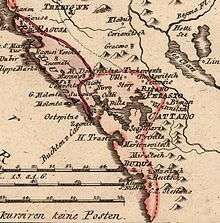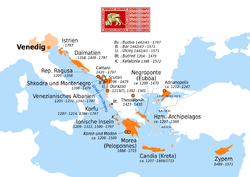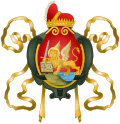Venetian Albania

Venetian Albania (Italian: Albania Veneta) was the name for the possessions of the Republic of Venice on the Southeastern Adriatic coast (southernmost Dalmatia) that existed from 1420 to 1797. It consisted of the Bay of Kotor, although initially it covered the coastal area of what is now Montenegro and northern Albania, most of which were lost to the Ottoman Empire early on.
Geography
The term "Venetian Albania" was used by the Republic for their initial possessions that stretched from the southern borders of the Republic of Ragusa to Durrës in coastal Albania. The Venetian territories usually reached only 20 km from the Adriatic Sea. Between the Siege of Shkodra and 1571 the territories in what is today Albania were lost.[1] After 1573 the southern limit was moved to the village of Kufin (which means border in Albanian) near Budva, because of the Ottoman conquests of Antivari (Bar), Dulcigno (Ulcinj), Scutari (Shkodër) and Durrës. The Venetian territory was then centered on the area of the Bay of Kotor, and included the towns of Kotor, Risan, Perast, Tivat, Herceg Novi, Budva, and Sutomore.
After 1797, the territory of "Venetian Albania" began stretching after the Republic of Ragusa, including the enclaves of Cattaro (Kotor) and Budua (Budva).[2]
History


The Venetians periodically controlled the small southern Dalmatian villages around the 10th century, but did not permanently assume control until 1420. The Venetians assimilated the Dalmatian language into the Venetian dialect quickly. The Venetian territories around Kotor lasted from 1420 to 1797 and were called Venetian Albania, a province of the Venetian Republic.[3]
In the early years of the Renaissance the territories under Venetian control included areas from actual coastal Montenegro to northern Albania up to Durrës: Venetians retained this city after a siege by the Ottoman Sultan Mehmed II in 1466 but it fell to Ottoman forces in 1501.
In those years Venetian Albania was relatively rich and the area around the city of Kotor enjoyed a huge cultural and artistic development.
When the Ottoman Empire started to conquer the Balkans in the 15th century, the population of Christian Slavs in Dalmatia increased greatly. As a consequence of this, by the end of the 17th century the Romance-speaking population of the historical Venetian Albania was a minority, according to Oscar Randi.[4]
After the French Republic conquered the Venetian Republic, the area of Venetian Albania became part of the Austrian Empire by the Treaty of Campo Formio, then the Napoleonic Kingdom of Italy by the Peace of Pressburg,[5] and then the French Illyrian Provinces by the Treaty of Schönbrunn. In 1814 it was again included in the Austrian Empire.
Towns
- Kotor
- Perast, once part of Venetian Albania, was at its peak in the 18th century, when it had as many as four active shipyards, a standing fleet of around a hundred ships, and 1,643 residents. At that time a number of architecturally significant buildings were constructed in this fortified town. Many ornate baroque palaces and houses were decorated the town of Perast, built in the Venetian style. Citizens of Perast (the population was around 1,600 at the time) enjoyed privileges from the Venetian Republic. They were allowed to trade with large ships and to sell goods without tax on the Venetian market, which created considerable income for the town.
- Budva
Population
According to the Dalmatian historian Luigi Paulucci (in his book Le Bocche di Cattaro nel 1810) the population of Venetian Albania, during the centuries of the Republic of Venice, was mainly Venetian speaking (approximately 66%) in the urban areas (Cattaro, Perasto, Budua, ecc..) around the "Bocche di Cattaro" (Bay of Kotor).
But in the inland areas more than half of the population was Serbo-Croatian speaking, after the first years of the eighteenth century. Paulucci wrote even that near the border with Albania there were big communities of Albanian speaking people: Ulcinj was half Albanian, one quarter Venetian and one quarter Slavic-speaking.[6]
Notable people
There were many notable people born in Bay of Kotor during the rule of Venice in those territories. For example, there were notable Italian-language writers in the 15th to the 18th century who originated from Venetian Albania, notably Giovanni Bona Boliris, Cristoforo Ivanovich and Ludovico Pasquali. Also, the first South Slavic printer Andrija Paltašić, was born in Kotor in 1440.[7]
Notes
- ↑ Cecchetti, Bartolomeo. Intorno agli stabilimenti politici della repubblica veneta nell'Albania. pp. 978–983.
- ↑ A Companion to Venetian History, 1400-1797. BRILL. 11 July 2013. pp. 134–. ISBN 978-90-04-25252-3.
- ↑ Durant, Will. The Renaissance. p. 121.
- ↑ Randi, Oscar. Dalmazia etnica, incontri e fusioni. pp. 37–38.
- ↑ Sumrada, Janez. Napoleon na Jadranu / Napoleon dans l'Adriatique. p. 159.
- ↑ Paulucci, Luigi. Le Bocche di Cattaro nel 1810 Edizioni Italo Svevo. Trieste, 2005.
- ↑ Bešić, Zarij M. (1970), Istorija Crne Gore / 2. Crna gora u doba oblasnih gospodara. (in Serbian), Titograd: Redakcija za istoriju Crne Gore
References
Bibliography
- Bartl, Peter. Le picciole Indie dei Veneziani. Zur Stellung Albaniens in den Handelsbeziehungen zwischen der Balkan- und der Appenninenhalbinsel. In: Münchner Zeitschrift für Balkankunde 4 (1981–1982) 1-10.
- Bartl, Peter. Der venezianische Türkenkrieg im Jahre 1690 nach den Briefen des päpstlichen Offiziers Guido Bonaventura. In: Südost-Forschungen 26 (1967) 88-101.
- Cecchetti, Bartolomeo. Intorno agli stabilimenti politici della repubblica veneta nell'Albania. In: Atti del Regio Istituto veneto di scienze, lettere ed arti. Bd. 3, Seria 4, S. 978-998. 1874.
- De Brodmann, Giuseppe. Memorie politico-economiche della citta e territorio di Trieste, della penisola d’Istria, della Dalmazia fu Veneta, di Ragusi e dell’Albania, ora congiunti all’Austriaco Impero. Venezia 1821.
- De Castro, Diego. Dalmazia, popolazione e composizione etnica. Cenno storico sul rapporto etnico tra Italiani e Slavi nella Dalmazia. ISPI 1978.
- Gelcich, Giuseppe. Memorie storiche sulle bocche di Cattaro. Zara 1880.
- F Hamilton Jackson (2010). The Shores of the Adriatic (Illustrated Edition). Echo Library. pp. 287–. ISBN 9781406867619. Retrieved 21 February 2011.
- Martin, John Jeffries. Venice Reconsidered. The History and Civilization of an Italian City-State, 1297–1797. Johns Hopkins UP. New York, 2002.
- Malcolm, Noel. Agents of Empire. Oxord UP. 2015.
- Norwich, John Julius. A History of Venice. Vintage Books. New York, 1989.
- Paulucci, Luigi. Le Bocche di Cattaro nel 1810 Edizioni Italo Svevo. Trieste, 2005.
- Schmitt, Oliver Jens (2001). Das venezianische Albanien (1392-1479). München: Oldenbourg Verlag. ISBN 978-3-486-56569-0.
.jpg)
.jpg)

